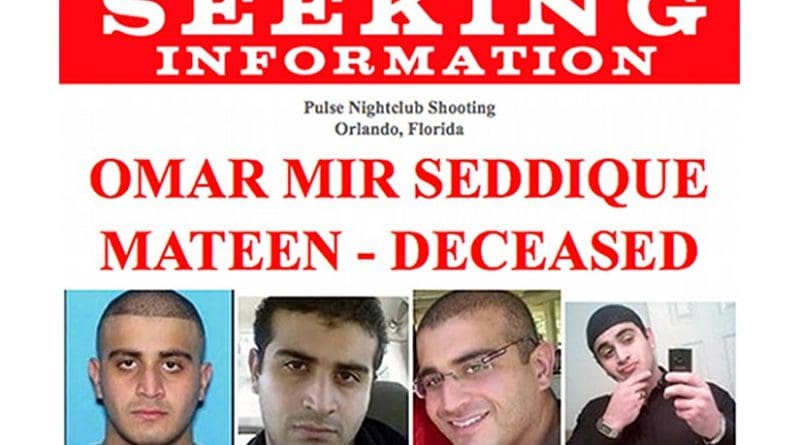Orlando Shootings: Threat Lies Within – Analysis
Early Sunday morning on 12 June, 29-year-old Omar Mateen, a U.S. citizen of Afghan descent perpetrated the worst mass shooting in the U.S. history that left 49 dead and scores injured at the Pulse nightclub in Orlando which is frequented by the LGBT community. The latest mass shooting, which went on for three hours, ended when Mateen was killed by police who stormed the scene.
Mateen, in 911 calls and Facebook posts during the attack at the nightclub, had pledged loyalty to the Islamic State (IS/ISIS) and its leader, Abu Bakr al-Baghdadi. Soon after the attack the IS-affiliated news agency Amaq News, broadcasted a claim that Mateen was an “ISIS fighter.”
The characteristics of the Orlando shooting is seen by some analysts as evidence that the nature of terrorism in the US is changing and the jihadists’ use of mass shootings could be the biggest change and challenge in dealing with terrorism since 9/11. This article looks at some of the peculiarities of the Orlando mass shooting.
The US authorities had issued advisories in recent weeks that IS-inspired individuals could respond with violence to a spate of defeats and loss of territory the IS had suffered in Iraq and Syria. The terror group was seen to be frustrated by the curbs on flow of recruits and funding. In a recent appeal, IS spokesman Abu Mohammed al-Adnani had called on the followers and sympathizers of IS in the west who were unable to join the IS in Iraq and Syria, to carry out suicide attacks in their home countries during Ramadan.
US officials familiar with the investigation into the massacre have been repeatedly stressing from the first day that there is no evidence yet to indicate a direct link with IS or any other militant group. Rather, Mateen was someone who was inspired over the internet; a do-it-yourself—DIY—terrorist. The US Congressional Research Service (CRS) in its report on Islamic State radicalization characterised such terrorists as being “largely isolated from the operational support of terrorist organizations, they acquired violent skills (however rudimentary) by themselves or relied on abilities that they had developed prior to becoming violent jihadists”.
The point being made is that the incident was not directed and funded by any foreign terrorist organization; hence the security framework put in place post 9/11 to deal with such threats originating outside the country, has not been compromised. While this may be reassuring to a certain section of the community and law enforcement agencies, the fact is this whether Mateen was IS-supported or IS-inspired is irrelevant to the outcome which saw loss of innocent lives and social dislocation. Islamist terror attacks within the US are reported to have significantly increased in the past one year, with Orlando being the 22nd instance since 2015.
However, in the case of Orlando shootings, the worry persists even after ruling out direct links. While the US president confirmed that Mateen was “self-radicalized” through materials he had found on the Internet, the FBI feels the Orlando shooting does not fit into a single category of hate crime, mass shooting, or jihadist act of terror.
The IS, as distinct from its peers, views spreading of fear as widely as possible also as a worthy objective. It seeks any disgruntled Muslim angry enough to pick up a gun as its ideal weapon. A ‘trojan’ with no warning indications of its cause, target and timing of attack till the attack itself has been carried out. A socially disruptive weapon in which the IS has never invested. Was Mateen such a ‘trojan’?
John Feffer, the director of Foreign Policy In Focus, frames the issue quite succinctly as the “last-minute marriage of convenience between Mateen and ISIS”. Feffer views Mateen declaration of allegiance to IS as an opportunistic act where “the shooter seemed to want to elevate his homophobic rampage to a higher level, and the IS was eager to demonstrate its capability to target the American homeland. The shooters and IS had no prior contact, but enthusiastically embraced each another through the act itself”.
The threat to the US comes from the number of such vulnerable individuals in the society and the IS’ ability to convince them to attribute their violence to the terror group as an initial step. This would provide fodder to the IS propaganda network and help it to create an environment to scale up its influence in attracting and actively bringing more susceptible individuals into its fold.
The situation in the near term could be more sensitive with a bitterly contested US presidential contest thriving on issues such as Islamic radicalisation, acceptance of migrants and gun control.
There would also be the realisation that Mateen was not the perfect ‘trojan’; he had been investigated by the FBI on two prior occasions for suspected links to terrorist organizations. Yet, he perpetrated the worst mass shooting in US history.
*Monish Gulati is an Associate Director at the Society for Policy Studies, New Delhi. He can be reached at: [email protected]. This article appeared at South Asia Monitor.

